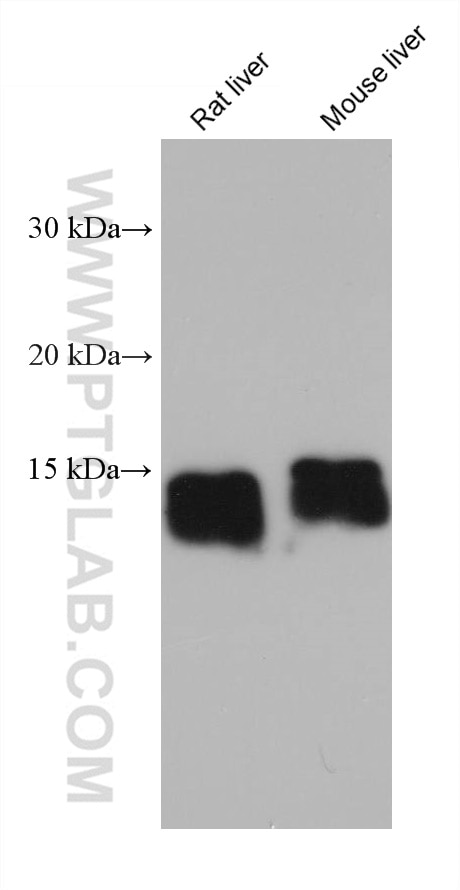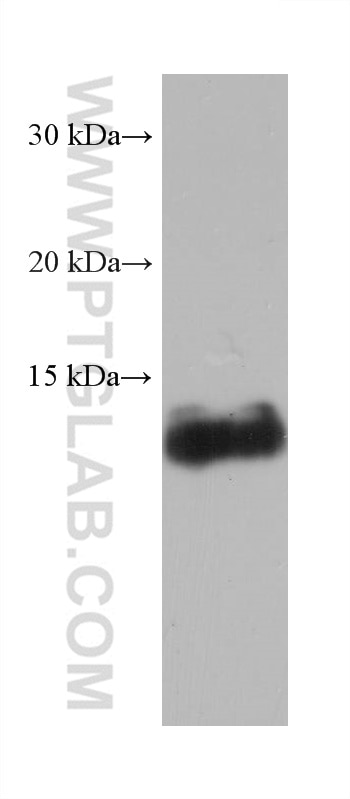FABP1 Monoklonaler Antikörper
FABP1 Monoklonal Antikörper für WB, ELISA
Wirt / Isotyp
Maus / IgG1
Getestete Reaktivität
Hausschwein, human, Maus, Ratte
Anwendung
WB, ELISA
Konjugation
Unkonjugiert
CloneNo.
1B6C8
Kat-Nr. : 68227-1-Ig
Synonyme
Galerie der Validierungsdaten
Geprüfte Anwendungen
| Erfolgreiche Detektion in WB | Rattenlebergewebe, Hausschwein-Lebergewebe, Mauslebergewebe |
Empfohlene Verdünnung
| Anwendung | Verdünnung |
|---|---|
| Western Blot (WB) | WB : 1:5000-1:50000 |
| It is recommended that this reagent should be titrated in each testing system to obtain optimal results. | |
| Sample-dependent, check data in validation data gallery | |
Produktinformation
68227-1-Ig bindet in WB, ELISA FABP1 und zeigt Reaktivität mit Hausschwein, human, Maus, Ratten
| Getestete Reaktivität | Hausschwein, human, Maus, Ratte |
| Wirt / Isotyp | Maus / IgG1 |
| Klonalität | Monoklonal |
| Typ | Antikörper |
| Immunogen | FABP1 fusion protein Ag32836 |
| Vollständiger Name | fatty acid binding protein 1, liver |
| Berechnetes Molekulargewicht | 127 aa, 14 kDa |
| Beobachtetes Molekulargewicht | 14 kDa |
| GenBank-Zugangsnummer | BC032801 |
| Gene symbol | FABP1 |
| Gene ID (NCBI) | 2168 |
| Konjugation | Unkonjugiert |
| Form | Liquid |
| Reinigungsmethode | Protein-G-Reinigung |
| Lagerungspuffer | PBS mit 0.02% Natriumazid und 50% Glycerin pH 7.3. |
| Lagerungsbedingungen | Bei -20°C lagern. Nach dem Versand ein Jahr lang stabil Aliquotieren ist bei -20oC Lagerung nicht notwendig. 20ul Größen enthalten 0,1% BSA. |
Hintergrundinformationen
FABP1, liver fatty acid-binding protein, is abundant in cytoplasm that regulates lipid transport and metabolism. It plays a role in lipoprotein-mediated cholesterol uptake in hepatocytes (PMID:25732850). FABP1 is mainly expressed in hepatocytes, enterocytes and to a lesser degree in renal tubular cells, associated with liver injury (PMID: 15653098). Levels of FABP1 was elevated in patients with hepatocyte injury secondary to alcohol or drug toxicity (PMID: 14563446).
Protokolle
| Produktspezifische Protokolle | |
|---|---|
| WB protocol for FABP1 antibody 68227-1-Ig | Protokoll herunterladen |
| Standard-Protokolle | |
|---|---|
| Klicken Sie hier, um unsere Standardprotokolle anzuzeigen |



